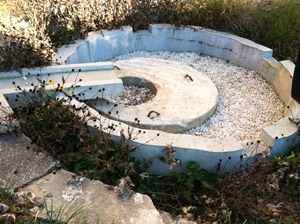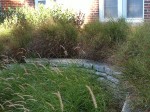At the ARCSA (American Rainwater Capture Systems Association) Annual Technical Conference the philosophical policy discussion rages on about whether rainwater should be considered stormwater, or infiltration and passive rainwater capture should be considered as valuable as active harvesting for use. This will be an ongoing debate for some time, since many of ARCSA’s sponsors and founding or long-time members promote particular products for rainwater harvesting and use in homes and businesses or in irrigation. The idea of promoting techniques that ANYONE can implement, like “SLOW, SPREAD, and SINK” definitely takes a back seat to the techniques that require professional installation or the treatment of rainwater to drinking standards. Since passive rainwater capture is central to G3’s Watershed Wise principles of valuing rainwater as a resource to eliminate wet weather runoff and recharge living soil for the benefits of plants, it was with some trepidation that G3’s Pamela Berstler joined G3 Certified Professional, and rainwater harvesting guru, Scott Mathers in Raleigh, NC .
Trepidation, however, was unwarranted, as this year’s topic of Urban Rainwater Capture included several presentations on stormwater and green infrastructure. The most interesting presentation of the first day was a discussion on Rainwater Quality by Dennis Lye of the EPA, Billy Kniffen of Texas AgriLife Extention, and Andy Fox, Assistant Professor of landscape architecture, urban design, green infrastructure and site construction at NCSU College of Design. Professor Fox discussed two projects implemented on the NCSU campus that, in addition to being au currant examples of green infrastructure, were conceived, designed, and constructed by NCSU design students for the benefit of the community living in campus housing. To the delight of 30 or 40 attendees, Professor Fox agreed to conduct a walking tour of the two installations.
First was a parkway retrofit along a busy street. The retrofit utilized existing stormwater infrastructure for the overflow (if any is generated), and altered the entire parkway into an excavated area approximately 12″ – 18″ below the grade of the adjacent thoroughfare.
No parking was eliminated by the retrofit, as the site originally had a “yellow zone” no parking designation. The BMP was installed in July 2012, and already has experienced several inches of rainfall via a series of late summer storms, including the most recent Hurricane Irene downpour (85% of the rainfall events in Raleigh are 1″ or less).
The second BMP was a Raingarden that converted an unused small path through an ivy-covered side of a main student residence hall into a well-traveled, popular walkway through an exuberant garden that collects first flush and more from the entire adjacent structure. The project was implemented by students through a ten week collaborative hands-on process in which they got the real life experience of convincing stakeholders of the value of the project, designing all details, pulling permits, preparing the site, and building the raingarden.
The result is a beautifully-executed, contemporary but classic rain gathering area that serves to gather students around the rain that is generated by and in the place they live. Students formed and poured concrete pads to slow the water at the downspout, convey it to an infiltration area, and move it around the site. The two infiltration areas were retained with urbanite (recycled concrete) cut into aesthetically appealing slabs. The North Carolina clay soil was amended with local shale shards and compost, resulting in a biologically diverse, rich, soil sponge that nurtures the plants and grabs the rainwater.







